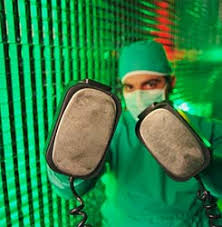
Alan was an interesting character. He was a vet who had qualified from Cambridge university. He was obviously intelligent but also somewhat a maverick. He drew great amusement from being controversial, as well as being witty to the clients.
I remember in one of his consultations, an owner of an epileptic dog (where the brain goes through episodes of spasms leading to fitting/seizuring), brought the dog in for recent fitting. This dog had been diagnosed for sometime with epilepsy and was prescribed the appropriate medication for the dog to decrease/stop the fitting. Unfortunately, the owner was not giving the medicine so the dog continued to seizure with increasing severity. Alan decided that the best way to illustrate the importance of medication, was to draw a picture of a dog standing with some round circles (representing tablets) and a "+"sign on the whiteboard in the consult room. This was his illustration for the dog on medicine. He then proceeded to draw another dog upside-down dead beside the first drawing. This he explained was the dog with no medicine!
Anyhow, there was one memorable incident involving Alan. On one particular day, an owner brought in her Golden Retriever dog who was off her food and showing signs of a brown vaginal discharge (pus). Alan went through the consultation discussing the signs the dog was showing and began his physical examination.
Alan often multi-tasked during consults, like a head chef in a busy kitchen! So he put a thermometer into the backside (anus) of the dog to take her temperature. The thermometer, which Alan used, was a traditional glass tube/straw with mercury inside. Normally it takes a couple of minutes for the thermometer to register the dog's body temperature.
Most vets hold the thermometer in place when taking the temperature. Alan however decided it was always more efficient to leave the thermometer in place (sticking out the backside!) and continue doing something else. So Alan continued to examine the dog from the head end - checking the eyes, gums and so on, while the thermometer was pointing out the dog's anus.
After a few minutes, Alan went to remove the thermometer to record the temperature; only to find that the thermometer had vanished! The dog's gut had sucked the thermometer into the dog just like a vacuum cleaner! Gentle probing with a gloved finger in the anus found nothing! The owner wasn't aware of what had happened so Alan acted calmly like nothing was wrong! Being made of glass and containing mercury, the thermometer could not be left in the dog and left to pass out naturally.
Fortunately, the dog had a serious infection of the uterus (pyometra) and so needed surgery to correct the condition (remove the uterus). Alan told the owner that the dog was in a serious condition and needed surgery as soon as possible. The owner agreed to allow Alan to operate so he took the dog straight to surgery (with the aim of removing the uterus and retrieving the lost thermometer).
Surgery to remove the uterus went well and Alan found that the thermometer had moved high up the colon. He massaged the gut wall pushing the thermometer downwards and eventually out of the anus (browner and smellier than before). The nurse removed the thermometer and put it safely away (from Alan!).
The dog made a full recovery from her uterine infection and surgery, although Alan never really did find out what her temperature was!
















































